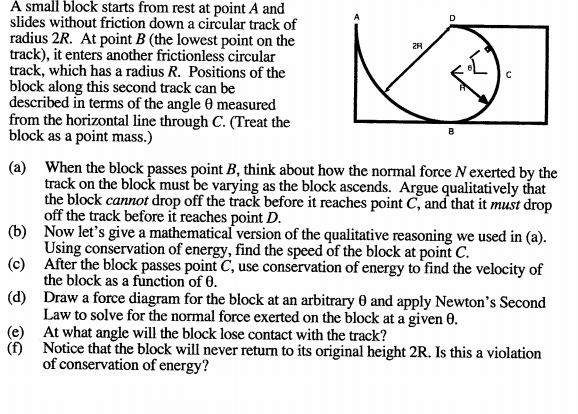A small block starts from rest at point A and slides without friction down a circular track of radius 2R. At point B (the lowest point on the track), it enters another frictionless circular track, which has a radius R. Positions of the block along this second track can be described in terms of the angle 0 measured from the horizontal line through C. (Treat the block as a point mass.) D. 2R (a) When the block passes point B, think about how the normal force N exerted by the track on the block must be varying as the block ascends. Argue qualitatively that the block cannot drop off the track before it reaches point C, and that it must drop off the track before it reaches point D. Now
A small block starts from rest at point A and slides without friction down a circular track of radius 2R. At point B (the lowest point on the track), it enters another frictionless circular track, which has a radius R. Positions of the block along this second track can be described in terms of the angle 0 measured from the horizontal line through C. (Treat the block as a point mass.) D. 2R (a) When the block passes point B, think about how the normal force N exerted by the track on the block must be varying as the block ascends. Argue qualitatively that the block cannot drop off the track before it reaches point C, and that it must drop off the track before it reaches point D. Now
Related questions
Question
I kindly ask that you help me with all the questions. Please do help me with this.

Transcribed Image Text:A small block starts from rest at point A and
slides without friction down a circular track of
radius 2R. At point B (the lowest point on the
track), it enters another frictionless circular
track, which has a radius R. Positions of the
block along this second track can be
described in terms of the angle 0 measured
from the horizontal line through C. (Treat the
block as a point mass.)
2R
(a) When the block passes point B, think about how the normal force Nexerted by the
track on the block must be varying as the block ascends. Argue qualitatively that
the block cannot drop off the track before it reaches point C, and that it must drop
off the track before it reaches point D.
(b) Now let's give a mathematical version of the qualitative reasoning we used in (a).
Using conservation of energy, find the speed of the block at point C.
(c) After the block passes point C, use conservation of energy to find the velocity of
the block as a function of 0.
(d) Draw a force diagram for the block at an arbitrary 0 and apply Newton's Second
Law to solve for the normal force exerted on the block at a given 0.
(e) At what angle will the block lose contact with the track?
(f) Notice that the block will never return to its original height 2R. Is this a violation
of conservation of energy?
Expert Solution
This question has been solved!
Explore an expertly crafted, step-by-step solution for a thorough understanding of key concepts.
This is a popular solution!
Trending now
This is a popular solution!
Step by step
Solved in 4 steps with 2 images
